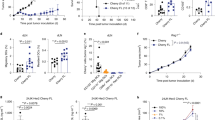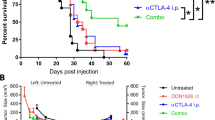Abstract
Therapeutic treatment with hu14.18-IL-2 immunocytokine (IC) or Flt3-L (FL) protein is initially effective at resolving established intradermal NXS2 neuroblastoma tumors in mice. However, many treated animals develop recurrent disease. We previously found that tumors recurring following natural killer (NK) mediated IC treatment show augmented MHC class I expression, while the tumors that recurred following T cell dependent Flt3-L treatment exhibited decreased MHC class I expression. We hypothesized that this divergent MHC modulation on recurrent tumors was due to therapy-specific immunoediting. We further postulated that combining IC and Flt3-L treatments might decrease the likelihood of recurrent disease by preventing MHC modulation as a mechanism for immune escape. We now report that combinatorial treatment of FL plus hu14.18-IL-2 IC provides greater antitumor benefit than treatment with either alone, suppressing development of recurrent disease. We administered FL by gene therapy using a clinically relevant approach: hydrodynamic limb vein (HLV) delivery of DNA for transgene expression by myofibers. Delivery of FL DNA by HLV injection in mice resulted in systemic expression of >10 ng/ml of FL in blood at day 3, and promoted up to a fourfold and tenfold increase in splenic NK and dendritic cells (DCs), respectively. Furthermore, the combination of FL gene therapy plus suboptimal IC treatment induced a greater expansion in the absolute number of splenic NK and DCs than achieved by individual component treatments. Mice that received combined FL gene therapy plus IC exhibited complete and durable resolution of established NXS2 tumors, and demonstrated protection from subsequent rechallenge with NXS2 tumor.


Similar content being viewed by others
Abbreviations
- CTL:
-
cytolytic T-lymphocyte
- DC:
-
dendritic cell
- Flt3-L:
-
fms-like tyrosine kinase 3 ligand
- IC:
-
immunocytokine
- NB:
-
neuroblastoma
- NK:
-
natural killer
- TAA:
-
tumor associated antigen
- TEV:
-
tumor escape variants
References
Algarra I, Cabrera T, Garrido F (2000) The HLA crossroad in tumor immunology. Hum Immunol 61:65–73
Algarra I, Garcia-Lora A, Cabrera T, Ruiz-Cabello F, Garrido F (2004) The selection of tumor variants with altered expression of classical and nonclassical MHC class I molecules: implications for tumor immune escape. Cancer Immunol Immunother 53:904–910
Bubenik J (2003) Tumour MHC class I downregulation and immunotherapy (review). Oncol Rep 10:2005–2008
Connor JP, Felder M, Hank J, Harter J, Gan J, Gillies SD, Sondel P (2004) Ex vivo evaluation of anti-EpCAM immunocytokine huKS-IL2 in ovarian cancer. J Immunother 27:211–219
Dunn GP, Old LJ, Schreiber RD (2004) The immunobiology of cancer immunosurveillance and immunoediting. Immunity 21:137–148
Dunn GP, Old LJ, Schreiber RD (2004) The three Es of cancer immunoediting. Annu Rev Immunol 22:329–360
Dunn GP, Bruce AT, Ikeda H, Old LJ, Schreiber RD (2002) Cancer immunoediting: from immunosurveillance to tumor escape. Nat Immunol 3:991–998
Dunn GP, Ikeda H, Bruce AT, Koebel C, Uppaluri R, Bui J, Chan R, Diamond M, White JM, Sheehan KC, Schreiber RD (2005) Interferon-gamma and cancer immunoediting. Immunol Res 32:231–245
Freedman RS, Vadhan-Raj S, Butts C, Savary C, Melichar B, Verschraegen C, Kavanagh JJ, Hicks ME, Levy LB, Folloder JK, Garcia ME (2003) Pilot study of Flt3 ligand comparing intraperitoneal with subcutaneous routes on hematologic and immunologic responses in patients with peritoneal carcinomatosis and mesotheliomas. Clin Cancer Res 9:5228–5237
Fruh K, Yang Y (1999) Antigen presentation by MHC class I and its regulation by interferon gamma. Curr Opin Immunol 11:76–81
Greene LA, Shain W, Chalazonitis A, Breakfield X, Minna J, Coon HG, Nirenberg M (1975) Neuronal properties of hybrid neuroblastoma X sympathetic ganglion cells. Proc Natl Acad Sci USA 72:4923–7
Gumperz JE, Parham P (1995) The enigma of the natural killer cell. Nature 378:245–248
Hagstrom JE, Hegge J, Zhang G, Noble M, Budker V, Lewis DL, Herweijer H, Wolff JA (2004) A facile nonviral method for delivering genes and siRNAs to skeletal muscle of mammalian limbs. Mol Ther 10:386–398
He Y, Pimenov AA, Nayak JV, Plowey J, Falo LD Jr, Huang L (2000) Intravenous injection of naked DNA encoding secreted flt3 ligand dramatically increases the number of dendritic cells and natural killer cells in vivo. Hum Gene Ther 11:547–554
Imboden M, Murphy KR, Rakhmilevich AL, Neal ZC, Xiang R, Reisfeld RA, Gillies SD, Sondel PM (2001) The level of MHC class I expression on murine adenocarcinoma can change the antitumor effector mechanism of immunocytokine therapy. Cancer Res 61:1500–1507
Kalinski P, Mailliard RB, Giermasz A, Zeh HJ, Basse P, Bartlett DL, Kirkwood JM, Lotze MT, Herberman RB (2005) Natural killer–dendritic cell cross-talk in cancer immunotherapy. Expert Opin Biol Ther 5:1303–1315
Kelly JM, Darcy PK, Markby JL, Godfrey DI, Takeda K, Yagita H, Smyth MJ (2002) Induction of tumor-specific T cell memory by NK cell-mediated tumor rejection. Nat Immunol 3:83–90
Khong HT, Restifo NP (2002) Natural selection of tumor variants in the generation of “tumor escape” phenotypes. Nat Immunol 3:999–1005
King DM, Albertini MR, Schalch H, Hank JA, Gan J, Surfus J, Mahvi D, Schiller JH, Warner T, Kim K, Eickhoff J, Kendra K, Reisfeld R, Gillies SD, Sondel P (2004) Phase I clinical trial of the immunocytokine EMD 273063 in melanoma patients. J Clin Oncol 22:4463–4473
Lanza F, Latorraca A, Moretti S, Castagnari B, Ferrari L, Castoldi G (1997) Comparative analysis of different permeabilization methods for the flow cytometry measurement of cytoplasmic myeloperoxidase and lysozyme in normal and leukemic cells. Cytometry 30:134–144
Liu F, Song Y, Liu D (1999) Hydrodynamics-based transfection in animals by systemic administration of plasmid DNA. Gene Ther 6:1258–1266
Lode HN, Xiang R, Varki NM, Dolman CS, Gillies SD, Reisfeld RA (1997) Targeted interleukin-2 therapy for spontaneous neuroblastoma metastases to bone marrow. J Natl Cancer Inst 89:1586–1594
Lode HN, Xiang R, Dreier T, Varki NM, Gillies SD, Reisfeld RA (1998) Natural killer cell-mediated eradication of neuroblastoma metastases to bone marrow by targeted interleukin-2 therapy. Blood 91:1706–1715
Lyman SD, James L, Johnson L, Brasel K, de Vries P, Escobar SS, Downey H, Splett RR, Beckmann MP, McKenna HJ (1994) Cloning of the human homologue of the murine flt3 ligand: a growth factor for early hematopoietic progenitor cells. Blood 83:2795–2801
Maraskovsky E, Brasel K, Teepe M, Roux ER, Lyman SD, Shortman K, McKenna HJ (1996) Dramatic increase in the numbers of functionally mature dendritic cells in Flt3 ligand-treated mice: multiple dendritic cell subpopulations identified. J Exp Med 184:1953–1962
Moretta A (2002) Natural killer cells and dendritic cells: rendezvous in abused tissues. Nat Rev Immunol 2:957–964
Munz C, Steinman RM, Fujii S (2005) Dendritic cell maturation by innate lymphocytes: coordinated stimulation of innate and adaptive immunity. J Exp Med 202:203–207
Neal ZC, Imboden M, Rakhmilevich AL, Kim KM, Hank JA, Surfus J, Dixon JR, Lode HN, Reisfeld RA, Gillies SD, Sondel PM (2004) NXS2 murine neuroblastomas express increased levels of MHC class I antigens upon recurrence following NK-dependent immunotherapy. Cancer Immunol Immunother 53:41–52
Neal ZC, Yang JC, Rakhmilevich AL, Buhtoiarov IN, Lum HE, Imboden M, Hank JA, Lode HN, Reisfeld RA, Gillies SD, Sondel PM (2004) Enhanced activity of hu14.18-IL2 immunocytokine against murine NXS2 neuroblastoma when combined with interleukin 2 therapy. Clin Cancer Res 10:4839–4847
Neal ZC, Bates MK, Albertini MR and Herweijer H (2007) Hydrodynamic limb vein delivery of a xenogeneic DNA cancer vaccine effectively induces antitumor immunity. Mol Ther 15:422–430
Rees RC, Mian S (1999) Selective MHC expression in tumours modulates adaptive and innate antitumour responses. Cancer Immunol Immunother 48:374–381
Reisfeld RA (1992) Potential of genetically engineered monoclonal antibodies for cancer immunotherapy. Pigment Cell Res Suppl 2:109–112
Shaw SG, Maung AA, Steptoe RJ, Thomson AW, Vujanovic NL (1998) Expansion of functional NK cells in multiple tissue compartments of mice treated with Flt3-ligand: implications for anti-cancer and anti-viral therapy. J Immunol 161:2817–2824
Silver DF, Hempling RE, Piver MS, Repasky EA (2000) Flt-3 ligand inhibits growth of human ovarian tumors engrafted in severe combined immunodeficient mice. Gynecol Oncol 77:377–382
Smyth MJ, Hayakawa Y, Takeda K, Yagita H (2002) New aspects of natural-killer-cell surveillance and therapy of cancer. Nat Rev Cancer 2:850–861
van Ojik HH, Bevaart L, Dahle CE, Bakker A, Jansen MJ, van Vugt MJ, van de Winkel JG, Weiner GJ (2003) CpG-A and B oligodeoxynucleotides enhance the efficacy of antibody therapy by activating different effector cell populations. Cancer Res 63:5595–5600
Vonderheide RH (2002) Telomerase as a universal tumor-associated antigen for cancer immunotherapy. Oncogene 21:674–679
Walzer T, Dalod M, Robbins SH, Zitvogel L, Vivier E (2005) Natural-killer cells and dendritic cells: “l’union fait la force”. Blood 106:2252–2258
Wells DJ (2004) Opening the floodgates: clinically applicable hydrodynamic delivery of plasmid DNA to skeletal muscle. Mol Ther 10:207–208
Zhang G, Budker V, Wolff JA (1999) High levels of foreign gene expression in hepatocytes after tail vein injections of naked plasmid DNA. Hum Gene Ther 10:1735–1737
Zimmermann S, Egeter O, Hausmann S, Lipford GB, Rocken M, Wagner H, Heeg K (1998) CpG oligodeoxynucleotides trigger protective and curative Th1 responses in lethal murine leishmaniasis. J Immunol 160:3627–3630
Acknowledgments
The authors thank Kathy Schell (Department of Human Oncology, University of Wisconsin-Madison, WI) for assistance with the flow cytometric analyses of excised tumors, and Drs. Jackie Hank, Ilia Buhtoiarov, Alexander Rakhmilevich, Ralph Reisfeld and Jon Wolff for helpful discussions. This work was supported in part by grants R01-063285 and R01-087025 from the National Institutes of Health and research support from The Midwest Athletes Against Childhood Cancer (MACC) Fund (PI, P.M. Sondel).
Author information
Authors and Affiliations
Corresponding author
Rights and permissions
About this article
Cite this article
Neal, Z.C., Sondel, P.M., Bates, M.K. et al. Flt3-L gene therapy enhances immunocytokine-mediated antitumor effects and induces long-term memory. Cancer Immunol Immunother 56, 1765–1774 (2007). https://doi.org/10.1007/s00262-007-0320-5
Received:
Accepted:
Published:
Issue Date:
DOI: https://doi.org/10.1007/s00262-007-0320-5




